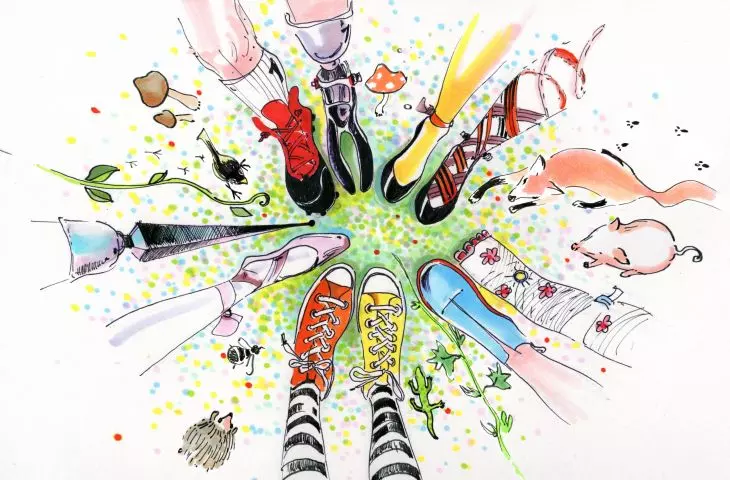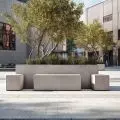A high quality of life for all is only possible if we take care of the excluded and the most vulnerable. That's what the economics of care is all about, as proclaimed by the CoopTech Hub in its next document. We discuss it with Joanna Erbel.
As part of our #ReportThursday series, we present documents, reports and guides on architecture, cities and local government that are certainly worth publicizing and promoting. This week we look at the document "Cooperative Equal Circles. The economics of care in action developed by CoopTech Hub with the Foundation for Social and Economic Initiatives.
Cooperative Equal Circles is the third report developed by CoopTech Hub, in which the authors seek to develop solutions that combine economics and social activities. The first report dealt with the creation of development cooperatives, and the second with urban farms - both of which we discussed with think tank expert Joanna Erbel.
In the latest document, the authors primarily address the issues of caring and nurturing people with disabilities, built on the cooperative model. Why is this so important? It's worth digging into the document.
The report is available on the Cooptech Hub initiative website.
CoopTech Hub's latest report addresses the economics of caring
il. Gosia Zmysłowska | © CoopTech Hub
without appearances and full satisfaction
The situation of people with disabilities in Poland, especially when finding their way in the labor market or becoming partially independent, is complicated. In 2019, only 28.8% of people with disabilities engaged in labor market activity, compared to 81% of non-disabled people of working age. Despite large national and EU funds - this result can hardly be considered satisfactory.
What are the barriers to becoming professionally active? Very often it is the lack of an appropriate supportive environment, a lack of understanding of the ergonomics necessary for people with disabilities to work, as well as trauma, loss of work or passive and active discrimination. An element that hinders the entry of people with disabilities into the labor market is, unfortunately, still the belief, which often persists in Poland, that there are no professional opportunities.
Where might the solutions lie? The authors of the report point to equal circles.
every circle is equal
The idea behind the Cooptech Hub is to appreciate and draw attention to the complexity of circles that can support people with disabilities in their professional and social activities. The first circle, self-help, consists of people with disabilities and their caregivers and caregivers. Next is the circle of support with volunteers and supporting organizations.
The next step is a circle of partnerships, where local companies, institutions and individuals can support financially and institutionally (e.g., through subscriptions) the entry into socio-professional activities. The last circle is about locality - anchoring in the local community.
The authors also refer to two models of cooperatives, which they wrote about more extensively in the first report.
Activation of people with disabilities can have diverse dimensions, but to be most effective, it must proceed holistically - taking into account the needs and creation of the environment.
The cooperative model is based on several local ecosystems that include people with disabilities
il. Gosia Zmysłowska | © CoopTech Hub
about the underestimated role of people with disabilities and ideas for the future of cooperatives is answered by Joanna Erbel - prototype creator and co-author of the report.
Wiktor Bochenek: As part of your upcoming reports, you present the topic of cooperatives - peer-to-peer? How can cooperatives help people with disabilities?
Joanna Erbel: For the past two years, we have been working on creating models and incubating cooperatives that aim to build local resilience. We believe that both caring for our environment and looking for ways to ensure our broader security must be based on solutions that see the potential of different social groups. Society is a complex system that needs a wide range of competencies and has the opportunity to give all willing people the opportunity to develop.
Social cooperatives have been activating people with disabilities for years. What is new in our proposal is to show how cooperatives focused on the needs of the most vulnerable can grow in strength when their activities are linked to the activities of other cooperatives, NGOs and companies. In the report "Cooperative Equal Circles. The economics of caring in action" we show how the model of caring cooperatives can be rooted in local community life.
The proposed cooperative solutions are based on four circles
il. Gosia Zmysłowska | © CoopTech Hub
When working on cooperatives that would be inclusive for people with disabilities, we decided to use the idea of circles of support that already existed and worked in other contexts. In doing so, we took inspiration from the model of the Polish Association for People with Intellectual Disabilities. We show how to gradually integrate people with disabilities. The circles that make up the cooperative are: the first, narrowest one is the self-help circle, it consists of people with disabilities, their caregivers (also professional) and advocates; in this inner circle self-help and value exchange takes place; - then the support circle, which includes volunteers and allied organizations; there integration events, respite care are organized and the wider community is involved. Within this circle, there are also recipients and recipients of products, as well as people who support the project with regular contributions.
The next circle is the circle of partnership brings together local companies, institutions, organizations, associations or individuals; through regular cooperation, people with disabilities receive financial and institutional support, commissioned cooperation in care work is provided, and the idea of subscriptions to various services performed by the cooperative can also be developed. The last circle is the circle of locality, which is a metaphorical and ideological creation rather than a physical or legal one. It is simply our neighborhood, or the space in which we live.
The situation of people with disabilities when finding their way in the labor market or becoming partially independent is complicated.
il. Gosia Zmysłowska | © CoopTech Hub
Wiktor: Can peers be created within existing cooperatives (e.g. we have a development cooperative that wants to set up a branch next door operating for OzN)?
Joanna: That's exactly right. Let me explain it with an example. Imagine that there is a cooperative urban farm in a community that grows vegetables and fruits. These are sold to both school cafeterias and local restaurants and cafes. Between the farm and the kitchen, there's another stop. To minimize waste, vegetables and fruits from are peeled and cut - this is handled by a social cooperative. In addition, it produces juices, purees and jams. Also, the farm space is a place where people working at the social cooperative can help perform various activities. Everything is close to each other - in the neighborhood. So people doing different activities - those with and without disabilities - meet each other both as part of their work and while in the neighborhood. They know each other by sight.
Cooperatives adapted to people with disabilities can be established inside existing cooperatives
il. Gosia Zmysłowska | © CoopTech Hub
Supporting our model is technology, which can make communication easier for many people, especially those who have trouble speaking, as well as making the entire ecosystem easier to operate. In addition, one can imagine that people who share their time and expertise get paid in the form of vouchers or other "tokens of goodness," where the reward for support is, for example, a discount on purchases. The key here is that the cooperative operates in both physical (in a given neighborhood, town or village) and digital spaces.
Each of these, of course, must be properly adapted to the needs of people with disabilities. It's a vision of an inclusive hybrid neighborhood where everyone and anyone feels at home.
Wiktor: Thank you for the interview.
The problems of people with disabilities are the lack of an appropriate supportive environment, the misunderstanding of ergonomics necessary and also trauma, loss of work or passive and active discrimination
il. Gosia Zmysłowska | © CoopTech Hub
The report is available on the Cooptech Hub initiative website.




































